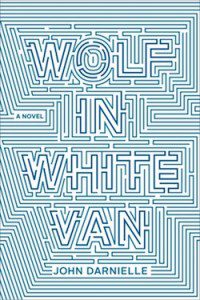
I believe it was Kurt Vonnegut who talked about how being a writer spoiled his innocence as a reader; if he was able to discern the structure of a book he would often stop reading it, no matter how beautifully written.
In the opening pages of John Darnielle’s Wolf in White Van, I felt I was seeing the novel’s bones materialize: disaffected narrator, hospital, something terrible has happened, we’re going backward in time, clues will be doled out in carefully allotted crumbs in a reverse Hansel-and-Gretel up to The Big Reveal That Explains Everything. And on top of all that: Sean the narrator’s face is grotesquely disfigured, lending an aspect of le mort vivant, à la Phantom of the Opera.
But unlike Vonnegut, I ventured on. And I was mentally sucked into the book by a stealthy undertow that necessitated no longer reading the book on the subway because I knew I would end up obliviously taking the train to its terminus instead of returning home. And I’ve never been more delighted to be so upended, to be so wrong in my first impression.
Sean is in his late thirties, but his speech is littered with contractions like “he would have had to’ve stopped,” which somehow makes him seem younger, like an impatient Holden Caulfield who can’t be bothered to write out the two extra letters. He’s seventeen at the time of the Disfiguring Event, and his narration zigzags between “now” and various childhood memories.
Because Sean cannot go outside without causing a ruckus—everyone looks at his face first—he supports himself by running a subscription play-by-mail game called the Trace Italian, a sort of choose-your-own-adventure that he created during the aftermath of the Disfiguring Event as he lay in a hospital bed, immobile, in an almost hallucinatory amount of pain. The object of the game is to survive various challenges (escaping from dungeons, foraging for food, deciding what to do when confronted with a dead fortune teller) and be the first to reach the labyrinthine fortress called the Trace Italian, which lives, fictionally, somewhere in Kansas. The Trace Italian itself is a structure inspired by the medieval trace italienne, a mazelike multiply fortified battlement, “stars within stars.” Even with the instant-gratification of the internet age, Sean stubbornly confines the game within the U.S. Postal Service, “slow gaming,” if you will. This gives him time to create and embellish his imaginative world, figure out the moves, and ruminate on the players and perhaps even subtly influence their fates.
This arrangement not only provides Sean with an income and independence, it allows him an interface with the outside world, where to the Trace Italian players he is someone to engage and curry favor with, instead of being a grotesque a bystander from whom people can’t wait to get away.
Because the book is written from inside Sean’s head, we don’t see his disfigurement; we only catch sporadic glimpses, like when he happens to see the glint of light off of some hardened scar tissue on his cheek. But because of this vantage point we get a clear view into the workings of his mind. Despite the spooky tone of the book, he’s actually very funny:
People look up from what they’re doing when I enter a building… on good days, I feel like my job is to try to set them at ease…
Unless they’re being gauche about it: covering their mouths with their hands like somebody in an old horror movie, or whispering loudly to somebody nearby. Then I pop open my jaw… and they get to see the inside of my mouth.

This voice has echoes of Darnielle’s previous novel, Master of Reality (part of the 33 1/3 series, where each book is written about an album), also written in a close first person, a series of diary entries by a Black Sabbath-obsessed teen who has been institutionalized for unnamed psychiatric and/or behavioral problems possibly related to this obsession.
Heavy metal is another link between the two books. Readers who remember vinyl albums will likely remember the kerfuffle over the rumor of “back masking”: secret messages embedded in records, which were revealed when you played the album backward. Kids everywhere ruined their needles trying to hear “Satan is king” and “smoking marijuana is fun.” Black Sabbath was an oft-accused culprit. So were the Beatles. My friend remembers actually being made to listen back masking in church (all the better to know the Satan they were up against). In 1990, a civil suit (later dismissed) was brought against Judas Priest, alleging that a subliminal message of “do it” caused a fan’s suicide.
The titular “wolf in white van” is a phrase supposedly back masked into a Christian rock song. Although it’s unparseable, this subliminal message, Sean tell us, “was a hellish picture to paint, and for young people to hear.”
The novel portrays not a binary between adult control and youth culture, but rather the great gray space in between. Darnielle’s American Eden is comprised of the twinkling lights of a southern California shopping center’s arcade, a childhood memory of the CBS nightly news, a gun store. It’s a world that presses upon Sean. Having made a decision that resulted in his never being able to fit into “normal” life again, Sean is the inverse of the Trace Italian players who make decisions in the game, with irreversible consequences.
What gripped me about this book, almost to the point of distress, is how it is so terrifyingly present. Sean observes his previous, pre-disfigured self as someone remote and separate from the person he is today. And given the isolated way he lives, he has no kind of future that anyone could predict. He manages to tear himself away from the constant chattering of society and simply spend time with himself, looking inward. The “now” of the novel is somewhere in the new century, but it rarely mentions technology. Sean hears a birdcall, but not a ringtone or the blurble of an incoming tweet.
Perhaps I’m reading or projecting more than I should, but the book works as a meditation on the radical presentness demanded for creativity. It should be noted that besides being a writer, Darnielle is also the vocalist and songwriter for the indie/folk/alt/rock/somewhat unclassifiable group the Mountain Goats. (I am a fan, but I feel fandom is irrelevant to the reading of the novel, as is this aspect of the author’s biography.) While he is confined to his bed, after the Terrible Thing That Disfigured Him, Sean’s creation of the world of the Trace Italian as he’s forced to stare up at the cracked ceiling day after day feels not unlike the novelist staring at the blank page, nervously waiting for the images to come, finding the flow, doing whatever is necessary to continue:
Somewhere in the middle of a long night, between one dosage of Darvocet and the next, I made a promise to myself. I remembered it now. I’d promised myself that all this was temporary, the medication and the bed in the room where the blinds were always down, and that I would get out of it somehow, get away somewhere, do something again with little reference to any of it. I didn’t promise myself future success or total recovery. Just escape.
Sean believes he can know what’s going to happen next, if he knows what the current situation is. But life is unpredictable. Darnielle nails that frustrating feeling of starting a work of art, having a distinct idea of where it should go, and then watching helplessly as it veers away from its original premise. In one scene, Sean sees a man in truck. He is so sure the man is going to turn and see him staring that he does an elaborate charade to make it look like he’s actually not looking. But as sure as he is—he even visualizes the man’s head turning—the man doesn’t look over. The story he’s created in his head, as much as he believes in it, doesn’t happen.
The novel doesn’t so much as end as arrive circuitously at the event alluded to at the beginning.
I won’t say what exactly happens. But at the Big Reveal The Explains Everything, I thought, Wait, that’s it? And after having ridden even the tiniest tributaries of Sean’s discursive thoughts to their ends, and gathered up the patches of his childhood memories, I was frustrated because I wasn’t sure I was convinced. If this were a student’s manuscript, I might have said in my teacherly voice, “What about the character’s motivation?”
This narrative vacuum may be precisely the point. Like the novel’s narrator, I have a tendency to “storify” almost anything I come into contact with (e.g., people on the subway), but after removing the causal relationships that we seek, we are left with an unsettling idea: there is no explanation for some truly horrible events. School shootings by disaffected, Sean-like teens come to mind. Perhaps the trickier feat Darnielle has pulled off is to use what isn’t there in the narrative rather than what is.
The Advanced Reader’s Copy I was sent looks like a flat black-and-white drawing of a maze. I only noticed after I finished reading that there’s a subtle iridescent shading to some of the letters, visible only when the cover is at a certain angle in a certain light. Similarly, under certain conditions we are all capable of impulsive acts, terribly irrational acts that make perfect sense at the time, and yet remain unexplainable, even to ourselves. Darnielle’s novel attempts to make sense of the insensible, to describe that inarticulable space where despite what came before, something still struggles to be born. As Sean notes:
The inside of the Trace Italian, of course, does not exist.
It both confirms my way of seeing and leaves me seeing differently. Like the best novels do.




